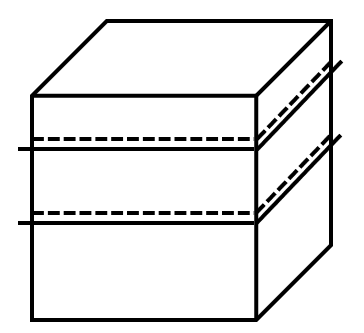AMC 8 Daily Practice - Solid Figures
Complete problem set with solutions and individual problem pages
A cube is cut by two planes parallel to its base, dividing it into three rectangular prisms. The ratio of the surface areas of these three prisms is . What is the ratio of their volumes?

- A.
- B.
- C.
- D.
- E.
As shown in the figure, let the edge length of the cube be , and let the heights of the three rectangular prisms be , , and respectively.
Thus, we have: .
The surface area of each rectangular prism includes the two base areas (each equal to ) and the lateral surface area (equal to since the base is a unit square).
Therefore, the surface areas of the three prisms are , , and respectively.
Given their ratio is , we have: .
Solving this proportion, we find: .
Since the volumes of the prisms (with the same base area) are proportional to their heights, the ratio of their volumes is equal to the ratio of their heights: .
